Some of the best bird photos
By Steven Brodsky
… that birders contributed to the Cornell Lab of Ornithology’s Macaulay Library archive in 2024 are accessible for you to view online.
Enjoy: https://www.allaboutbirds.org/news/macaulay-librarys-best-bird-photos-2024/.
Posted 1-13-25
If you want to become a Pennsylvania Fish and Boat Commission (PFBC) Waterways Conservation Officer (WCO) Trainee
By Steven Brodsky
… information in this press release from the Pennsylvania Fish and Boat Commission (PFBC) could be helpful to you:
HARRISBURG, Pa. (January 6) — The Pennsylvania Fish and Boat Commission (PFBC) is recruiting the 27th class of Waterways Conservation Officer (WCO) Trainees.
The State Civil Service Commission (SCSC) will begin accepting applications now through February 3, 2025. The class of trainees will undergo a comprehensive training program at various training sites in the Commonwealth, including the PFBC’s H.R. Stackhouse School of Fishery Conservation and Watercraft Safety in Bellefonte, Centre County. Trainees will study law enforcement principles and practices, fish and boat laws, watercraft safety, environmental protection, and other related content. The class of trainees is expected to report for training later this year and graduate in the summer of 2026.
“Waterways Conservation Officers are law enforcement professionals who have a passion for the outdoors and work to protect, conserve, and enhance Pennsylvania’s aquatic resources,” said Col. Jeffrey Sabo, Director of the PFBC Bureau of Law Enforcement. “If you’re seeking a career that is filled with adventure and sense of purpose, don’t let this opportunity pass you by.”
WCOs are specifically trained in all aspects of fisheries conservation and watercraft safety and work to preserve fishing and boating opportunities on Pennsylvania’s 86,000 miles of rivers, streams, and lakes. WCOs enjoy working outdoors and have an unmatched appreciation for the hundreds of native species of fish, reptiles, and amphibians that call Pennsylvania home.
Applications will only be accepted online. To view the announcement and apply, please visit the Pennsylvania employment website at: www.employment.pa.gov.
Applicants must meet the following basic criteria:
• Pennsylvania residency
• Possess a valid driver’s license
• Be at least 21 years of age
• High School Graduate or GED
• Pass a criminal history background check
Upon submitting an application for this position, applicants will be required to take the SCSC exam no later than March 5th, 2025.
For more information on the position, visit the WCO Recruitment page on the PFBC website (Fishandboat.com). For questions, email: RA-FBBLERECRUITING@pa.gov.
Posted 1-9-25
At the right time and right place
By Steven Brodsky
… a gentle encounter with an element of winter can be serendipitous.
On the first evening of winter 2025, this poem by Robert Frost reminds us of this: Dust of Snow by Robert Frost | Poetry Foundation.
Similar (and surprising) beneficial encounters await many of us this season.
Enjoy winter 2025!
Posted 1-1-25
Attention boaters: the Pennsylvania Fish and Boat Commission (PFBC) has announced the availability of a new online boating safety education course
By Steven Brodsky
… Details about this course were revealed in a press release that was issued by the Pennsylvania Fish and Boat Commission (PFBC).
From that press release:
HARRISBURG, Pa. (December 5) – The Pennsylvania Fish and Boat Commission (PFBC) is excited to announce the availability of a new, low-cost online boating safety education course!
The course, offered in partnership with the nonprofit BoatUS Foundation for Boating Safety and Clean Water, is available for only $17, is approved by both the PFBC and National Association of State Boating Law Administrators (NASBLA), and recognized by the United States Coast Guard.
In Pennsylvania, a Boating Safety Education Certificate is required for any person born on or after January 1, 1982, to operate boats powered with motors greater than 25 horsepower or any personal watercraft. To receive a certificate, boaters must successfully complete an approved boating safety course – either online or through in-person instruction.
The BoatUS Foundation course consists of six lessons and quizzes along with a final exam. Students may use a computer or mobile device to start, pause, and resume their learning at any time, and the full course can be completed in approximately four-to-eight hours. Individuals who successfully complete the online course will immediately receive a temporary Boater Safety Education Certificate which can be printed and is valid for 60 days. Within four-to-six weeks, students will receive their permanent certificate in the mail in the form of a durable plastic card that is valid for the boater’s lifetime.
“Not only does this boating safety course come at a great value and convenience, but it’s also proven that this type of education saves lives,” said Paul Littman, Director of the PFBC’s Bureau of Boating. “Approximately 75% of boating fatalities occur on boats where the operator did not have any formal boating safety education. There’s never been a better time to earn your certificate than right now thanks to this partnership.”
To access the course, visit the PFBC website (FishandBoat.com), and the select the BoatUS Foundation option.
Posted 12-8-24
It wasn’t you, nor was it me
By Steven Brodsky
… who made this tree:
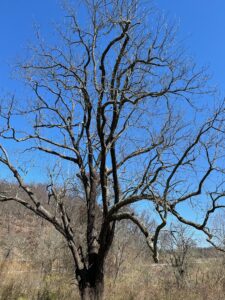
Photo by Steven Brodsky
“Trees,” by Joyce Kilmer: https://www.poetryfoundation.org/poetrymagazine/poems/12744/trees
The tree was photographed yesterday.
The Joyce Kilmer poem was published in August 1915.
This post originally appeared at: Conversations About Faith – delcoculturevultures.com.
Posted 3-25-24, Reposted and Revised 11-21-24
The Pennsylvania Department of Transportation (PennDOT) is offering a new PA Sportsman license plate; this specialty plate will benefit youth hunting and fishing programs
By Steven Brodsky
… The new PA Sportsman license plate was unveiled yesterday, September 30, 2024.
Video of the license plate unveiling ceremony:
From a news release issued by the Pennsylvania Game Commission (PGC) and the Pennsylvania Fish and Boat Commission (PFBC):
HARRISBURG, Pa. (September 30) — Just in time for the fall hunting and fishing seasons, the Pennsylvania Game Commission (PGC) and Pennsylvania Fish and Boat Commission (PFBC) are excited to announce the offering of the new PA Sportsman license plate!
The specialty plate, available now through the Pennsylvania Department of Transportation (PennDOT), is adorned with artwork featuring iconic Pennsylvania hunting, fishing, and boating imagery including the white-tailed deer, ruffed grouse, and anglers fishing from a kayak on a scenic river. The license plate costs $40 plus the registration fee, of which $14 will be deposited into a Youth Hunting and Fishing Restricted Account to be allocated evenly to the PGC and PFBC for the purpose of promoting youth hunting and fishing activities.
“The outdoors are important to so many Pennsylvanians, and our state’s outdoor resources – both now and in the future – depend upon the people who care enough to protect them,” said PGC Executive Director Steve Smith. “Hunters, trappers, boaters and anglers play an active role in conserving fish and wildlife and their habitats, but the torch they carry ultimately will be passed to the generations to come, highlighting the continual need to involve youth in these activities and shape them as stewards who one day can pass the torch to those who follow. With this license plate, sportsmen and sportswomen can help that cause while showing their pride in the things that make it all possible.”
PFBC Executive Director Tim Schaeffer reinforced the value of growing youth education programs around conservation-based recreational activities and stressed the importance of safety for those who enjoy the woods and the water.
“Fishing and boating are year-round lifetime activities for individuals and families in Pennsylvania,” said Schaeffer. “It’s critical that we introduce young people to outdoor recreation and instill a conservation ethic early on. Equipped with the skills needed to enjoy all that Pennsylvania’s waters have to offer, they are also more likely to become stewards of our aquatic resources. To me, the best part of the license plate may be that the adult and child depicted are wearing their life jackets. It will be great to have that public safety reminder on roadways across the Commonwealth.”
Both the PGC and PFBC have youth education programs that encourage interest in outdoor recreational activities including hunting, trapping, fishing, boating, and conservation.
Popular PFBC youth programs include Trout in the Classroom (TIC), which provides educational experiences for students and teachers who raise Rainbow Trout from eggs to fingerling-size fish in aquariums as part of their school curriculums. During the 2023-24-25 school year, 57,114 students in 417 classrooms across 61 counties participated in TIC. Additionally, each year on the Saturday before the statewide opening day of trout season in April, the PFBC holds its Mentored Youth Trout Fishing Day. This special day is offered annually to allow youth participants ages 15 and under to learn how to become successful, ethical anglers while fishing with their licensed adult mentors.
The PGC reaches into more than 300 schools statewide through its administration of the National Archery in the Schools Program and offers educational curricula through its Wildlife on WiFi and Seedlings for Schools programs. Junior Game Warden Camps held each summer provide an opportunity for youth to experience the broad scope of work performed by conservation officers, while organized Junior Pheasant Hunts might give young hunters their first glimpse of the action that awaits them afield.
These programs are just a snapshot of each agency’s involvement with youth.
The Pennsylvania Department of Transportation (PennDOT) offers several special fund registration plates, including the PA Sportsman plate. These plates support various causes across the Commonwealth from preserving Pennsylvania’s heritage to honoring veterans.
“Our goal was to help create a design that resonates with everyone who enjoys the outdoors while serving as a reminder of Pennsylvania’s abundant wildlife,” said PennDOT Secretary Mike Carroll. “When you display this plate, it tells other Pennsylvanians and people throughout the country that you’re a dedicated hunter, an enthusiastic fisherman, or someone who supports the state’s natural resources.”
The PA Sportsman license plate was created through Act 51 of 2024 which was signed into law by Gov. Josh Shapiro on July 8, 2024. The legislation, sponsored by Senator Wayne Langerholc, Jr. (PA-35), designates the funds generated by sales of the plates to youth hunting and fishing programs in Pennsylvania.
“This license plate allows our rich heritage of hunting and fishing to be proudly displayed by motorists while raising money for future generations of hunters and fishermen,” said Langerholc. “I look forward to seeing these beautiful license plates displayed on vehicles as I travel throughout my district and beyond, knowing that we’re keeping kids involved in the outdoors.”
Members of the Pennsylvania Governor’s Youth Council for Hunting, Fishing and Conservation (Youth Council) joined in celebrating the offering of the PA Sportsman license plate, noting the need for additional funding for programs that engage their young peers in outdoor recreational opportunities.
“Empowering youth through access and opportunity to outdoor recreation like hunting and fishing not only builds a deeper connection to our natural resources but also builds Pennsylvania’s next generation of conservation leaders,” said Grace Ziegmont, Youth Council President. “Programs supported by this license plate will reach a wide diversity of Pennsylvania’s youth and help empower them to protect and steward our fish and wildlife resource for generations yet to come.”
To purchase a PA Sportsman specialty license plate, visit the PennDOT website, choose Special Fund, and select the PA Sportsman option.
For more information on youth hunting, fishing, and boating education programs, visit the PGC and PFBC websites.
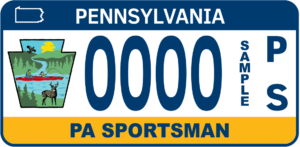
Image courtesy of the Pennsylvania Department of Transportation (PennDOT)
Posted 10-1-24
In a proper season
By Steven Brodsky
… appeared this frog (and the shadow it cast upon a lotus leaf):
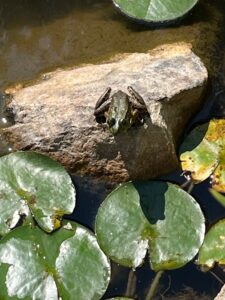
Photo by Steven Brodsky
Ecclesiastes 3 KJV (biblehub.com)
This post appeared in the Conversations About Faith section of this column.
Posted 4-25-24, Reposted and Revised 8-14-24
Exquisite is the monarch butterfly chrysalis stage
By Steven Brodsky
… as pictured here:

Photo by Steven Brodsky
I can’t say that I find the adult stage of the monarch butterfly to be more exquisite than the monarch chrysalis stage.
Which stage is more exquisite?
Not an easy question (for me) to answer.
It’s easier to simply enjoy seeing these two life stages of the monarch butterfly in the great outdoors!
Posted 8-7-24
Coming into the peace of some wild things
By Steven Brodsky
… with this photo and “The Peace of Wild Things”:
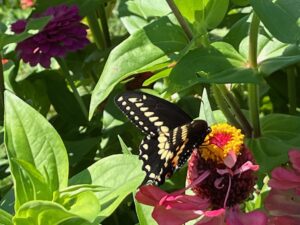
Photo by Steven Brodsky
Posted 7-9-24
‘Nature rarer uses yellow’
By Steven Brodsky
… wrote Emily Dickinson: https://www.online-literature.com/dickinson/poems-series-2/106/.
Thought of the poem today when this early spring spattering of translucent yellow came into view trailside in a National Park:
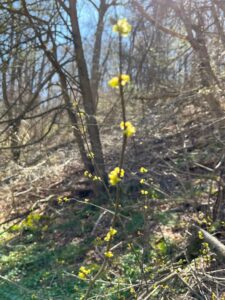
Photo by Steven Brodsky
Some of this column’s readers will recall the Emily Dickinson poem the next time that they take notice of nature’s yellow in the great outdoors.
Posted 3-24-24
A tarantula species was named after Johnny Cash 8 years ago, on February 5, 2016
By Steven Brodsky
… The species is found near Folsom State Prison, the venue where Johnny Cash’s first live album, Johnny Cash at Folsom Prison, was recorded on January 13, 1968. The album was released on May 6, 1968.
Folsom State Prison is located in Folsom, California.
The tarantula species is named Aphonopelma johnnycashi: http://www.sci-news.com/biology/aphonopelma-johnnycashi-new-tarantula-species-johnny-cash-03615.html.
Posted 2-5-24
Most people can relate
By Steven Brodsky
… to the kind of death that was experienced by the character in Seamus Heaney’s poem “Death of a Naturalist.”
Posted 7-12-22
A Conversation With Katie Fallon, Author of ‘Vulture: The Private Life of an Unloved Bird’
By Steven Brodsky
Katie Fallon is a co-founder of the Avian Conservation Center of Appalachia. She’s worked with many species of raptors and other kinds of birds. Katie’s books include Cerulean Blues (2011) and the recently released Vulture: The Private Life of an Unloved Bird. Her essays have appeared in a number of literary journals. She has a lifelong love of nature. I’ve heard that the first word she ever spoke was “bird.”
Your new book gives vultures, particularly turkey vultures, the positive attention these non-predator raptors deserve. What brought about your interest in these maligned birds?
I’ve been fascinated by vultures for at least fifteen years. There was a roost near where I lived in West Virginia; every day I’d drive by this big, old dead tree with ten or so turkey vultures hunched in it. They became a familiar sight, and I looked forward to seeing them. Vultures are big and kind of dramatic, and in flight, there’s nothing more beautiful. In addition, they’re the ultimate recyclers—they turn death into life.
Many people in the U.S. have an aversion to vultures. Speak about this.
I think vultures remind people of their own mortality. It can be a little creepy to think about a large, dark bird waiting to consume your body when you die. In general, I don’t think people in the US are comfortable with thinking of our bodies as food. Vultures remind us that life will continue after we die, and that some life will continue because we die. They remind us of our animal bodies. Which can be unnerving!
In the absence of vultures, we’d have major health issues to contend with. Tell us why.
Vultures clean up our ecosystems by removing animal carcasses that could potentially contaminate soil and water. They can eat animals that have died of anthrax and botulism. In the absence of vultures, mammalian scavengers could increase in number, and many mammalian scavengers such as raccoons, skunks, feral dogs and cats can spread rabies; vultures do not. Several vulture species in India have suffered catastrophic population crashes in the last twenty years, and public health has suffered. India leads the world in human rabies cases, and the number of cases has increased as the number of feral dogs increased in the absence of vultures.
People get close to vultures by attending your presentations that feature non-releasable birds. How are these birds acquired? How are they trained?
The nonprofit I co-founded, the Avian Conservation Center of Appalachia, keeps eight non-releasable raptors for educational purposes (you need permits from the US Fish & Wildlife Service to do this, of course – the birds aren’t pets or personal property). All of our birds were injured wild birds that cannot return to the wild. We have three vultures. Lew the turkey vulture was hit by a car and suffered an injury to his shoulder that prevents flight. His “girlfriend,” Boris, was shot in the wing, and by the time she reached us the bone had already healed incorrectly. Our black vulture is Maverick, and he was hit by a car, which resulted in a shoulder injury that prevents adequate flight.
Our birds are all trained using positive reinforcement. We avoid negative reinforcement and punishment, and we try to empower the birds to have some control over their environments. We condition behaviors by offering food rewards when the birds perform the behaviors. Vultures (especially our black vulture!) learn quickly, and they are a lot of fun to work with.
What myths and misunderstandings about vultures do these presentations help to dispel?
People are surprised at how clean and charismatic the vultures are – and how beautiful they are up close, despite their featherless heads.
What vulture behaviors do people find to be most interesting?
People often ask if vultures throw up on us; our education vultures usually don’t (unless they get scared). Vultures also expel liquid waste on their legs and feet, probably to clean them as well as to keep cool. This often fascinates people as well.
Which species of vulture are found in Pennsylvania and neighboring states?
We have turkey vultures and black vultures. During the last Ice Age we may have had California condors, too, and possibly some other now-extinct vultures.
What has been learned about migration of these species?
Hawk Mountain has taken the lead on turkey vulture migration research. Dr. Keith Bildstein and his team have placed transmitters and wing tags on turkey vultures all over the Americas. They’ve learned that our eastern turkey vultures are partial migrants—some spend the winters in Florida, some on the New Jersey shore, some in Virginia, and in many places in between. Many western turkey vultures are complete migrants, leaving their breeding ranges in Canada and heading all the way to South America. And still others in the American southwest migrate into Central America and return. It’s fascinating how the different subspecies have different migratory strategies. Dr. Bildstein and his colleagues have ongoing research projects about turkey vulture migration, and are discovering more all the time.
Vultures have spectacular flying ability. What makes this possible?
Turkey vultures are very light – they have almost the same wingspan as a bald eagle but weigh less than half what an eagle weighs. Their wings are long and broad, and are made for soaring.
How high can they fly?
The Ruppell’s vulture holds the record for the highest-flying bird. Unfortunately for that individual, it was hit and killed by a jet flying over Africa at 37,000 feet.
Vulture: The Private Life of an Unloved Bird informs readers about lead toxicity in vultures. What is the extent of the problem? How do vultures ingest lead?
Vultures (and eagles, hawks, crows, ravens, and owls) can ingest small pieces of spent lead ammunition in animal carcasses or “gut piles” left by hunters. When someone shoots a white-tailed deer, for example, the deer is usually field-dressed, and many of the organs are left. This can be a delight for vultures and other scavengers! In ecosystems, scavengers often follow the big predators to clean up the leftovers; here, the same thing is happening—a human is the big predator, a gut pile is the leftover, and a vulture or eagle is the scavenger. However, if small lead fragments are still in the gut piles, avian scavengers can inadvertently ingest the lead and become sick. Lead toxicity from spent ammunition is the biggest obstacle in the way of California condor recovery.
The Avian Conservation Center of Appalachia provides rehabilitation for injured birds. What kind of care do vultures receive?
We’ve treated vultures with a wide variety of injuries and ailments—broken bones, head trauma, lead toxicity, soft tissue injuries. Every bird we admit receives an immediate comprehensive examination by an avian veterinarian, and is then treated as necessary with antibiotics, antifungals, anti-inflammatories, fluid therapy, or chelation therapy. They also receive orthopedic surgery if necessary. We do our best to get the birds back out in the wild if possible.
It must be very joyful to enable an injured bird to regain flight ability. Please tell us about a memorable release.
Two and a half years ago we released a female turkey vulture that had been shot with a shotgun—she had three pellets embedded in soft tissue. We had to leave the pellets in her body because removing them would cause damage. Once she was nursed back to health, we released her wearing a transmitter to track her movements. We learned that she travels to northern Georgia in the winters and comes back to West Virginia in the breeding season. We are thrilled that this vulture was able to return to the wild—and thrive!
Vulture watching is growing in popularity. Turkey vultures are very widespread. Where are some of the best places and times to observe them?
In many parts of the southeastern United States, you can see turkey vultures any day of the year in a variety of habitats. In the winter, vultures can be observed roosting together in and near many cities: in Virginia, check out Leesburg, Staunton, Radford, Pulaski, and Charlottesville; in West Virginia, many vultures can be observed migrating in the fall over Hanging Rock Tower in Monroe County and over Harper’s Ferry in the eastern panhandle. During the summer and fall, the overlook at Cooper’s Rock State Forest near Morgantown, WV, is a sure place to see turkey vultures. Hawk Mountain in Pennsylvania, of course, is an excellent place to watch turkey vultures and birds of prey during migration, especially in September and October.
What stimulated your interest in nature?
I’ve always been an outdoors person. I grew up in northeastern Pennsylvania, and I had horses as a kid. I spent a great deal of time with my horses, trail riding and competing, and when I got a bit older I often went hiking and camping with friends and family. One of my favorite childhood hiking spots was Ricketts Glen State Park—it’s filled with hemlock trees and many gorgeous waterfalls. It’s definitely worth checking out if you visit northeastern PA.
Was “bird” your first word?
Yes! My parents had bird feeders in their yard when I was a baby (well, they still do) and my mother says she used to hold me in front of the window to show me the birds at the feeder. One day, she said, “Look at the birds! Look at the birds outside.” And I nodded and said, “Bird.” I haven’t stopped talking about them since.
Katie Fallon’s website address is: www.katiefallon.com.
Posted 4-6-17, Reposted 10-29-19